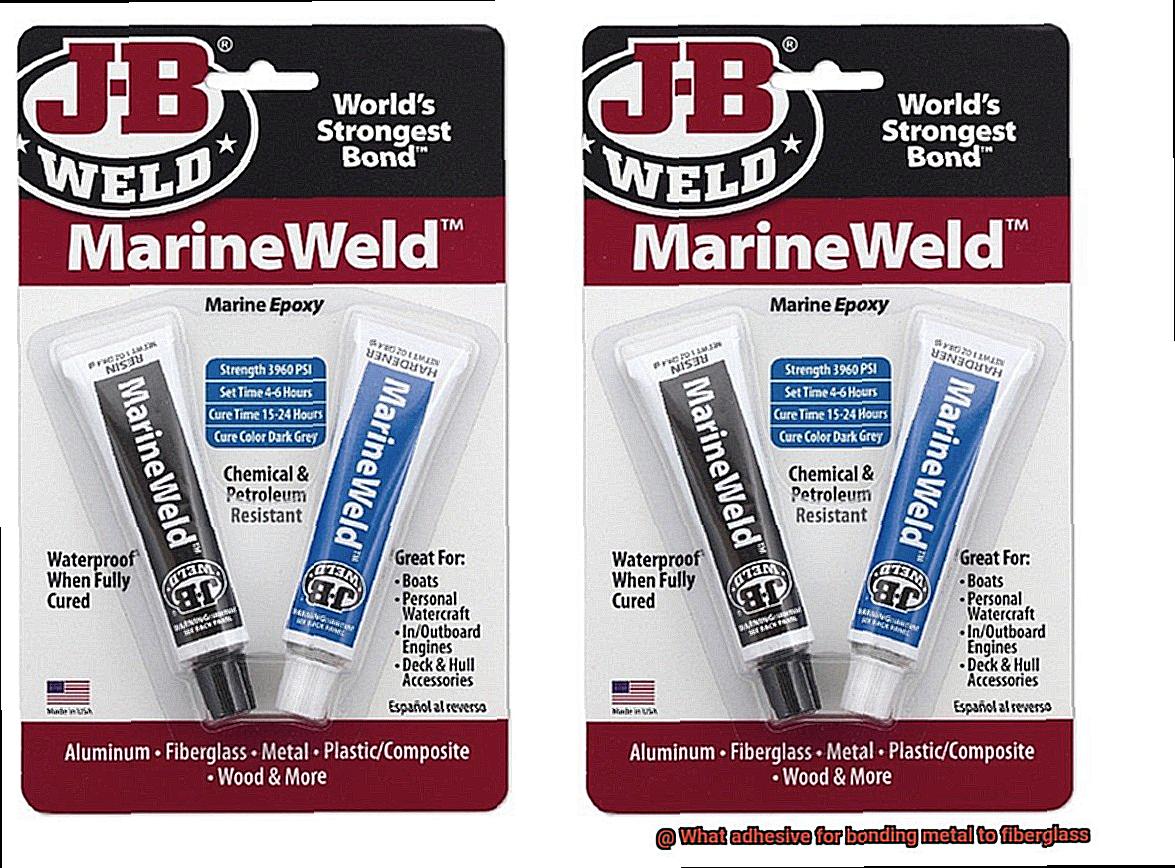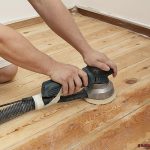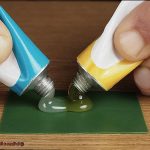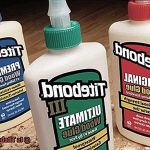Are you searching for a reliable method to bond metal and fiberglass?
Look no further. In this blog post, we’ll explore the world of adhesives and uncover the best options for bonding these two materials.
Whether you’re working on a DIY project or tackling a professional job, finding the right adhesive is essential for creating a strong and durable bond. Join us as we delve into the fascinating world of adhesives and discover the secrets to successfully bonding metal to fiberglass.
Get ready to elevate your projects to new heights.
Types of Adhesives for Bonding Metal to Fiberglass
Contents
- 1 Types of Adhesives for Bonding Metal to Fiberglass
- 2 Epoxy
- 3 Polyurethane
- 4 Acrylic
- 5 Specialized Adhesives
- 6 Factors to Consider When Choosing an Adhesive
- 7 Preparing the Surfaces for Bonding
- 8 Application Techniques, Curing Times, and Safety Precautions
- 9 Benefits of Using Adhesives for Bonding Metal to Fiberglass
- 10 Common Challenges Faced When Bonding Metal to Fiberglass
- 11 Conclusion
Adhesives are the unsung heroes in the world of bonding, ensuring that metal parts securely attach to fiberglass surfaces. Choosing the right adhesive for bonding metal to fiberglass is crucial for a strong and durable connection. In this blog post, we will explore different types of adhesives, discuss their advantages and disadvantages, and provide tips for successful bonding.
Epoxy Adhesive:
Epoxy adhesives are the superheroes of bonding metal to fiberglass. They are incredibly strong, durable, and resistant to heat, chemicals, and moisture. However, they require precise mixing ratios and have a limited working time, making them somewhat tricky to use.
Despite these challenges, epoxy adhesives offer unmatched bonding strength and are ideal for applications where reliability is paramount.
Polyurethane Adhesive:
When flexibility is essential, polyurethane adhesives come to the rescue. These adhesives provide high-strength bonds that can withstand a wide range of temperatures. Additionally, they are resistant to impacts, vibrations, and harsh weather conditions.
Although polyurethane adhesives may be more expensive than other options, their flexibility makes them suitable for outdoor applications where bonded materials may experience movement.
Acrylic Adhesive:
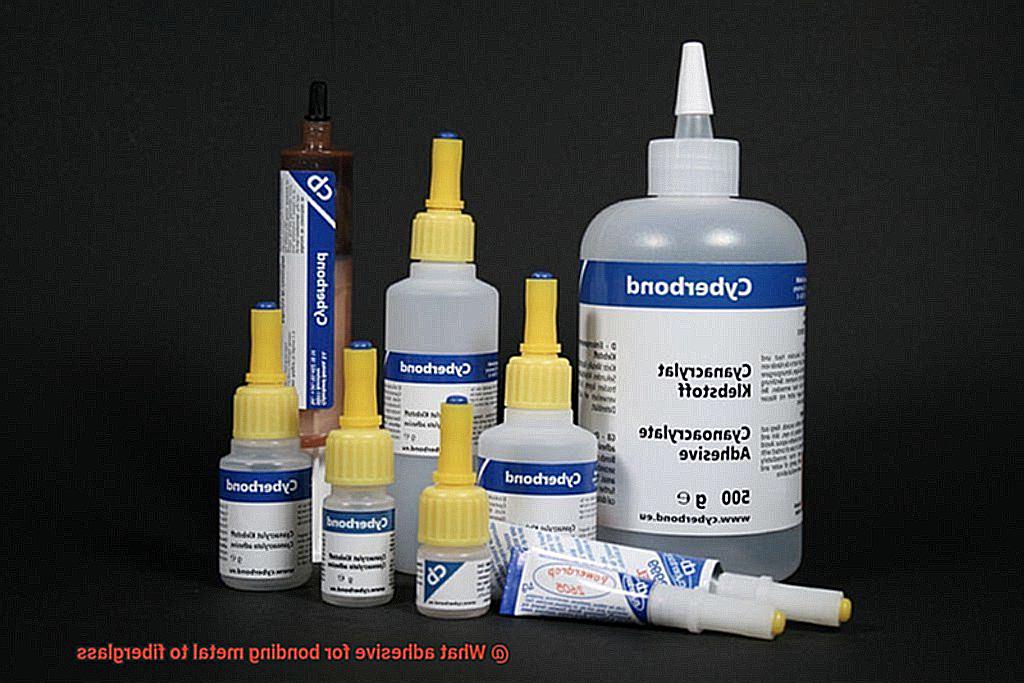
When time is of the essence, acrylic adhesives save the day. These fast-curing adhesives offer high strength and bond various materials, including metal and fiberglass. Acrylic adhesives also have excellent resistance to temperature fluctuations, UV radiation, and chemicals.
Their fast-curing property makes them ideal for time-sensitive projects or applications where quick results are required.
Cyanoacrylate Adhesive:
For smaller metal parts, cyanoacrylate adhesives are the go-to choice. These super glue-like adhesives dry quickly and form strong bonds. However, they may not be suitable for larger or load-bearing applications as they can be brittle and may not withstand extreme conditions.
Cyanoacrylate adhesives are ideal for precision bonding, such as securing delicate metal components to fiberglass surfaces.
Silicone Adhesive:
When flexibility is essential, silicone adhesives are the answer. They can handle high temperatures and offer excellent adhesion to both metal and fiberglass. Silicone adhesives are commonly used in industries like automotive and aerospace, where extreme conditions are a factor.
With their ability to withstand temperature fluctuations and provide long-lasting bonds, silicone adhesives are a reliable choice for bonding metal to fiberglass.
Choosing the right adhesive for bonding metal to fiberglass is crucial for achieving a strong and durable bond. Each type of adhesive has its own strengths and limitations, so it’s important to consider the specific requirements of the application. Proper surface preparation and following manufacturer’s instructions are key to success.
Epoxy
Step into the world of adhesives and discover the superhero known as epoxy – the ultimate choice for bonding metal to fiberglass. With its incredible strength and durability, epoxy acts as a shield against the elements, forming an unyielding bond that withstands stress and keeps metal and fiberglass united.
In this article, we will explore the advantages of using epoxy for this purpose and learn how to harness its powers for successful bonding.
Advantage #1: Resilience against the Elements
Epoxy is like a superhero shield, protecting your bond from moisture, chemicals, and temperature fluctuations. Whether it’s indoors or outdoors, rain or shine, hot or cold, epoxy remains steadfast in its mission to keep metal and fiberglass united.
Advantage #2: Unyielding Bond Strength
Epoxy unleashes its superpowers when it comes to strength. It creates a strong and permanent bond between metal and fiberglass surfaces, ensuring they stay connected even under stress. Impact or vibration won’t stand a chance against this mighty adhesive.
Advantage #3: Surface Preparation is Key
Just like any superhero, epoxy needs proper preparation before it can save the day. Clean, dry surfaces free from dirt or grease are essential. Lightly sanding the surfaces creates a rough texture that enhances adhesion. Following these steps ensures your bond is as strong as it can be.
Advantage #4: Mixing and Curing for Success
To activate its powers, epoxy requires a mix of resin and hardener in the correct ratio. Thoroughly mixing them until a uniform color is achieved is crucial for success. Once applied, the bond should be clamped or secured until the epoxy cures completely. Follow the manufacturer’s instructions for optimal results.
Polyurethane
In a world where metal and fiberglass come together to create the perfect bond, one adhesive stands out as the superhero that saves the day. Polyurethane adhesive possesses incredible powers that make it the ultimate choice for successfully bonding metal to fiberglass. Let’s explore the extraordinary advantages of using polyurethane adhesive and discover why it is the go-to glue for creating unbreakable, flexible, and durable bonds.
Advantage 1: Versatility Unleashed
Polyurethane adhesive possesses a remarkable ability to bond different materials, including metal and fiberglass. Its versatile nature allows it to create strong bonds that can withstand vibrations, temperature changes, and impacts. No matter the challenging conditions your bonded materials face, polyurethane adhesive has got you covered.
Advantage 2: Defying the Elements
When bonding metal to fiberglass, exposure to moisture, chemicals, and UV radiation is inevitable. Luckily, polyurethane adhesive excels in resisting these elements. Its water and chemical resistance ensure the durability and longevity of your bond, even in harsh environments.
Advantage 3: Flexibility at its Finest
Materials expand and contract with temperature changes and movement. But fear not – polyurethane adhesive is here to save the day. Its excellent flexibility allows it to accommodate these movements without compromising the bond. Say goodbye to cracks or breaks caused by material expansion or contraction.
Advantage 4: Easy Application, Swift Results
Polyurethane adhesive comes in various forms, such as liquid or paste, making it incredibly easy to apply on different surfaces. Its quick curing time means you can achieve a strong bond in no time. Whether you’re working on a large-scale project or a quick repair job, polyurethane adhesive ensures efficient bonding.
Surface Preparation: Unleashing Full Potential
Before diving into the world of polyurethane adhesive bonding, it’s important to note that surface preparation is key. Clean and roughen the surfaces to be bonded, following the manufacturer’s instructions for optimal adhesion. Remember, even superheroes need proper training to unleash their full potential.
Acrylic
With its unparalleled strength, versatility, and resistance, acrylic adhesive is the ultimate glue for metal-to-fiberglass bonding. In this blog post, we will dive into the world of acrylic adhesive and explore why it is the go-to choice for various applications.
Versatility at its Finest:
Acrylic adhesive is a true chameleon. It effortlessly bonds dissimilar materials like metal and fiberglass, making it perfect for restoring vintage cars or constructing boats. This adhesive forms a strong and durable bond that ensures your metal and fiberglass stay firmly attached, even when faced with stress or vibrations.
Resistance to the Elements:
Mother Nature can be tough, but acrylic adhesive is tougher. This superhero glue boasts excellent resistance to temperature fluctuations, chemicals, and UV radiation. Say goodbye to worries about your metal-framed greenhouse or fiberglass boat deteriorating under harsh weather conditions.
Easy to Use, Even for Novices:
Acrylic adhesive doesn’t discriminate against skill levels. It comes in pre-mixed or two-component systems, making it accessible for both beginners and seasoned pros. The pre-mixed adhesive is ready to go straight out of the tube, while the two-component system requires a quick mix with a catalyst. Whichever option you choose, rest assured that you’ll achieve excellent bonding strength and flexibility.
Surface Preparation is Key:
Just like any superhero needs proper training before saving the day, surface preparation is crucial when using acrylic adhesive. Make sure to clean your surfaces thoroughly to remove any dirt or grease that could hinder the bonding process. Abrading the surfaces with sandpaper or applying a primer can further enhance adhesion, ensuring a rock-solid bond.
Specialized Adhesives
When it comes to uniting metal and fiberglass, the choice of adhesive is paramount for a bond that withstands the test of time. Fortunately, specialized adhesives are available to cater specifically to this need. In this article, we delve into the realm of specialized adhesives used for bonding metal to fiberglass, exploring their types and highlighting the importance of meticulous surface preparation.
Types of Specialized Adhesives:
- Epoxy Adhesives: With their unrivaled strength and adaptability, epoxy adhesives reign supreme. Comprising two components – resin and hardener – that merge upon mixing, epoxy adhesives forge formidable connections between metal and fiberglass surfaces. Their resilience extends to heat, chemicals, and moisture, ensuring reliability in even the harshest conditions.
- Polyurethane Adhesives: Known for their remarkable bonding strength and flexibility, polyurethane adhesives are masters of endurance. Capable of withstanding intense impacts and vibrations, they thrive in applications where movement or stress places demands on the bond line. Additionally, these adhesives boast resistance to weathering and UV exposure.
- Specialized Adhesives: Tailored to the unique task of bonding metal to fiberglass, specialized adhesives offer enhanced adhesion capabilities or exhibit specific curing characteristics. These tailored features make them ideally suited for this particular bonding application, ensuring optimal results.
Importance of Surface Preparation:
Surface preparation is a critical step that should never be overlooked when utilizing any adhesive for bonding metal to fiberglass. Both the metal and fiberglass surfaces must undergo thorough cleansing to eliminate any traces of oil, grease, or dirt. To enhance adhesion properties, sanding or roughening the surfaces may be necessary.
Why is surface preparation crucial? Picture it as preparing a pristine canvas for an adhesive masterpiece. An unclean or contaminated surface hampers the adhesive’s ability to create a robust bond, resulting in a feeble, unreliable connection. By diligently preparing the surfaces, we pave the way for the adhesive to establish a firm grip and maximize its bonding potential.
Factors to Consider When Choosing an Adhesive
When it comes to choosing an adhesive for bonding metal to fiberglass, there are several important factors to consider. The right adhesive can make all the difference in creating a strong and durable bond that can withstand even the toughest conditions. So, let’s dive into what you need to think about when making your decision.
First and foremost, compatibility is key. You want an adhesive that is specifically formulated to bond metal and fiberglass together. It should adhere well to both surfaces, ensuring a strong and long-lasting bond.
Strength is another crucial factor. Your adhesive should have sufficient strength to withstand any forces or stresses that the bonded assembly may encounter. Whether it’s vibrations, impacts, or other mechanical stresses, your adhesive should be up for the challenge.
Flexibility is also important. Metal and fiberglass have different levels of flexibility, so you need an adhesive that can accommodate these differences. It should be able to flex and move with the materials without losing its bond strength. This is especially crucial if your bonded assembly will experience changes in temperature or thermal expansion/contraction.
Chemical resistance is another key consideration. Depending on your application, your bonded assembly may be exposed to various chemicals or environmental conditions. You want an adhesive that can withstand exposure to water, oils, solvents, and other common substances without deteriorating or weakening its bond.
Cure time is another factor to take into account. Some adhesives require longer curing periods, while others offer fast cure times. Consider your project’s timeline and requirements when choosing an adhesive. Shorter cure times can significantly reduce production or assembly time, making them more convenient for certain applications.
Next, think about the application method of the adhesive. Some adhesives come in liquid form, while others are available as tapes or films. Consider the ease of application and whether it suits your specific project requirements.
Temperature resistance is crucial as well. If your bonded assembly will be exposed to high temperatures, you need an adhesive that can withstand those temperatures without losing its bond strength. Similarly, if your assembly will be exposed to extreme cold temperatures, the adhesive should remain effective under those conditions as well.
Lastly, consider the cost of the adhesive. While it may be tempting to opt for a cheaper option, compromising on quality can lead to weaker bonds or potential failures in the long run. Find a balance between cost and performance that fits your budget.
Preparing the Surfaces for Bonding
When it comes to bonding metal and fiberglass surfaces, proper preparation is essential for a strong and durable bond. Just like finding the perfect partner, choosing the right adhesive is important, but preparing the surfaces beforehand sets the stage for success. Let’s explore the necessary steps to prepare metal and fiberglass surfaces for bonding.
Step 1: Clean the Metal Surface:
Picture trying to stick two surfaces together with dirt, grease, or rust in between – a recipe for failure. Begin by cleaning the metal surface using a degreaser or solvent like acetone or isopropyl alcohol. Thoroughly remove all contaminants that could hinder the bonding process.
Step 2: Roughen Up the Metal Surface:
To enhance adhesion, give your metal surface some texture. Utilize sandpaper or a wire brush to create microscopic grooves and scratches. These imperfections increase the surface area for the adhesive to grip onto, ensuring a stronger bond.
Step 3: Cleanse the Fiberglass Surface:
Now let’s shift our attention to the fiberglass surface. Just like with metal, it’s crucial to eliminate any dirt, grease, or wax. Use a mild detergent or soap mixed with water for cleaning. Rinse thoroughly and allow the surface to completely dry before proceeding.
Step 4: Give Fiberglass a Light Sanding:
If your fiberglass surface is smooth or glossy, it may impede adhesion. Overcome this obstacle by lightly sanding the surface with fine-grit sandpaper. This creates a slightly rougher texture that allows the adhesive to form a stronger bond.
Step 5: Aligning the Surfaces:
Before applying adhesive, ensure both surfaces are properly aligned. Carefully position the metal and fiberglass pieces together so they fit snugly without any gaps or misalignments. This step guarantees a seamless and secure bond.
Application Techniques, Curing Times, and Safety Precautions
To ensure a successful and safe bond, it’s crucial to understand the application techniques, curing times, and safety precautions involved. Let’s unravel the secrets of a strong and lasting connection.
Application Techniques:
- Cleanliness is key: Thoroughly clean both metal and fiberglass surfaces using a solvent or degreaser to remove any dirt, grease, or oil that could hinder adhesion.
- Roughen up: Gently roughen the surfaces with fine-grit sandpaper to create tiny grooves that improve adhesion. Wipe away dust or debris afterward.
- Follow instructions: Each adhesive has its own rules. Carefully follow the manufacturer’s instructions, whether it involves mixing the adhesive or applying it directly from a tube or cartridge.
- Apply with finesse: Use a brush, roller, or recommended applicator to apply a thin, even layer of adhesive to both surfaces. Apply enough for a strong bond but avoid excess that may cause messiness or squeeze-out.
Curing Times:
- Patience is key: Curing times vary depending on the adhesive type. Refer to the manufacturer’s instructions for specific curing times.
- Let it bond: During curing, chemical reactions occur within the adhesive, resulting in cross-linking and hardening. Allow enough time for the bond to fully develop and achieve maximum strength.
- Factors that matter: Temperature, humidity, and adhesive formulation can influence curing times. Higher temperatures speed up curing, while lower temperatures slow it down. Humidity levels also play a part.
- Don’t rush it: Avoid subjecting the bonded metal and fiberglass to stress or load until sufficient curing time has passed as premature exposure to stress can weaken the bond.
Safety Precautions:
- Breathe easy: Work in a well-ventilated area to minimize exposure to adhesive fumes or vapors. Consider additional ventilation for enclosed spaces.
- Gear up: Wear proper personal protective equipment (PPE) such as gloves, safety glasses, and a respirator if recommended by the adhesive manufacturer.
- Handle with care: Some adhesives may be flammable or emit harmful fumes during curing. Read and follow all safety precautions provided by the manufacturer to ensure safe handling and application.
- Clean up and store responsibly: Clean any accidental adhesive contact immediately with soap and water. Store adhesives in a cool, dry place away from heat sources and open flames, following the manufacturer’s storage recommendations.
Benefits of Using Adhesives for Bonding Metal to Fiberglass
When it comes to bonding metal to fiberglass, using adhesives offers a multitude of benefits that will surely leave you impressed. Adhesives provide a strong and durable bond between metal and fiberglass, ensuring longevity and reliability. Unlike mechanical fasteners like screws or bolts, adhesives create a chemical bond that securely holds the two materials together, even under extreme conditions. This means that your bond will withstand the test of time.
But strength is not the only advantage of adhesive bonding. Adhesives also offer flexibility in design and application. They can be applied evenly across the entire bonding surface, eliminating the need for additional hardware. This not only creates a streamlined and aesthetically pleasing finished product but also allows for greater design freedom. With adhesives, you can easily bond complex shapes and curves without compromising structural integrity.
Another benefit of adhesive bonding is its ability to distribute stress evenly throughout the bonded area. This reduces the risk of stress concentration points that can lead to material failure. This is especially important when bonding materials with different properties, such as metal and fiberglass. Adhesives ensure that the load is evenly distributed, increasing the overall strength of the bond.
But wait, there’s more. Adhesive bonding creates a protective barrier against environmental elements. The adhesive forms a layer that seals out moisture, preventing corrosion and rust from forming on the metal surface. It also keeps dirt, dust, and other contaminants at bay, ensuring that your bond remains intact over time.
And let’s not forget about vibration damping properties. Adhesives reduce noise and vibration in bonded structures, making them ideal for applications where noise reduction is essential. Think about it – a quieter ride in your car or a smoother flight in an aircraft. Adhesives make it possible.
Not only are adhesives effective, but they are also cost-effective. While the initial cost of adhesive may be higher than traditional fasteners, adhesive bonding eliminates the need for expensive tools and equipment. It also reduces labor costs as it is a simpler and quicker process. So not only do you get a strong bond, but you also save money – win-win.
And that’s not all. Adhesives provide improved weight distribution, as they are lightweight compared to traditional fasteners. This is particularly advantageous in industries where weight reduction is critical, such as aerospace or automotive. Additionally, adhesives can provide electrical insulation properties, preventing electrical conductivity between the metal and fiberglass components. This is essential in applications where electrical isolation is required to avoid short circuits or interference.
Common Challenges Faced When Bonding Metal to Fiberglass
Bonding metal to fiberglass can be a daunting task, as it involves overcoming several common challenges. These challenges stem from the distinct physical properties of the two materials and require careful consideration to ensure a strong and enduring bond.
One of the primary challenges when bonding metal to fiberglass is the difference in thermal expansion coefficients. Metal and fiberglass have disparate rates of expansion and contraction when exposed to temperature variations. This discrepancy places stress on the bond line, leading to potential cracking or delamination of the adhesive. Overcoming this challenge necessitates selecting an adhesive that can accommodate the differential thermal expansion and contraction between the metal and fiberglass.
Another hurdle is the disparity in surface roughness and porosity between metal and fiberglass. Metal surfaces tend to be smooth and non-porous, while fiberglass surfaces can be rough and porous. This difference directly impacts the adhesion of the adhesive to both materials. To ensure optimal adhesion, thorough surface preparation involving cleaning, degreasing, and roughening is essential.
Moisture poses yet another challenge when bonding metal to fiberglass. Certain adhesives may weaken or degrade over time when exposed to moisture. Overcoming this challenge requires selecting an adhesive that is moisture-resistant, maintaining its strength and integrity even in humid or wet conditions.
Additionally, compatibility between the adhesive and both metal and fiberglass is crucial. Different adhesives possess distinct chemical compositions and properties that may not be compatible with both materials. Selecting an adhesive specifically designed for bonding metal to fiberglass and ensuring its compatibility through testing is vital.
Lastly, mechanical stress poses a challenge during the bonding process. The bond may encounter various forms of stress, including tension, compression, or shear forces. Selecting an adhesive capable of withstanding these stresses is imperative to achieve a robust and durable bond.
ImmqS_faFLs” >
Conclusion
When it comes to bonding metal to fiberglass, choosing the right adhesive is crucial. You need a strong and reliable solution that can withstand the demands of this unique bond. Luckily, there are several options available that can get the job done effectively.
One popular choice is epoxy adhesive. This versatile adhesive offers excellent bonding strength and durability. It forms a strong chemical bond between the metal and fiberglass surfaces, creating a long-lasting connection that can withstand various environmental conditions.
Another option worth considering is polyurethane adhesive. Known for its exceptional flexibility and resistance to moisture, polyurethane adhesive provides a reliable bond between metal and fiberglass. It also offers good impact resistance, making it suitable for applications where vibrations or shocks may occur.
If you’re looking for an adhesive that offers quick curing time, cyanoacrylate adhesive might be your best bet. Commonly known as super glue, this fast-acting adhesive bonds metal to fiberglass in no time. However, keep in mind that it may not be as durable as other options and may require additional support for heavy-duty applications.
For high-stress applications requiring maximum strength, structural adhesives such as methacrylate or epoxy-based formulas are ideal choices. These adhesives offer exceptional bonding performance, ensuring a secure connection between metal and fiberglass even under extreme conditions.
No matter which adhesive you choose, proper surface preparation is key to achieving a successful bond. Make sure to clean both the metal and fiberglass surfaces thoroughly before applying the adhesive. Roughening the surfaces with sandpaper or using a primer can also enhance the bond strength.
In conclusion, when it comes to bonding metal to fiberglass, selecting the right adhesive is essential for a strong and durable connection. Whether you opt for epoxy, polyurethane, cyanoacrylate, or structural adhesives, make sure to follow proper surface preparation techniques for optimal results.

